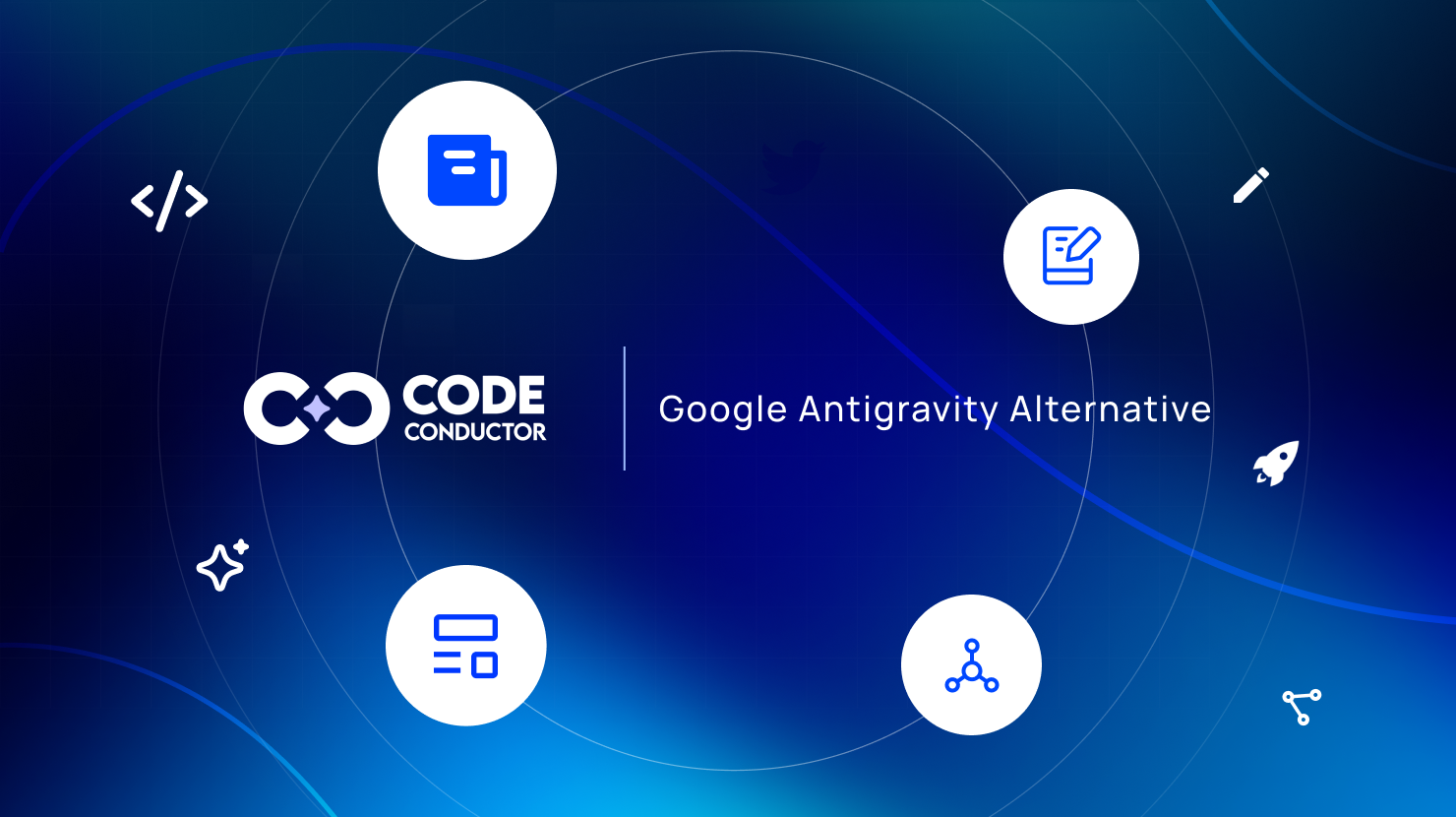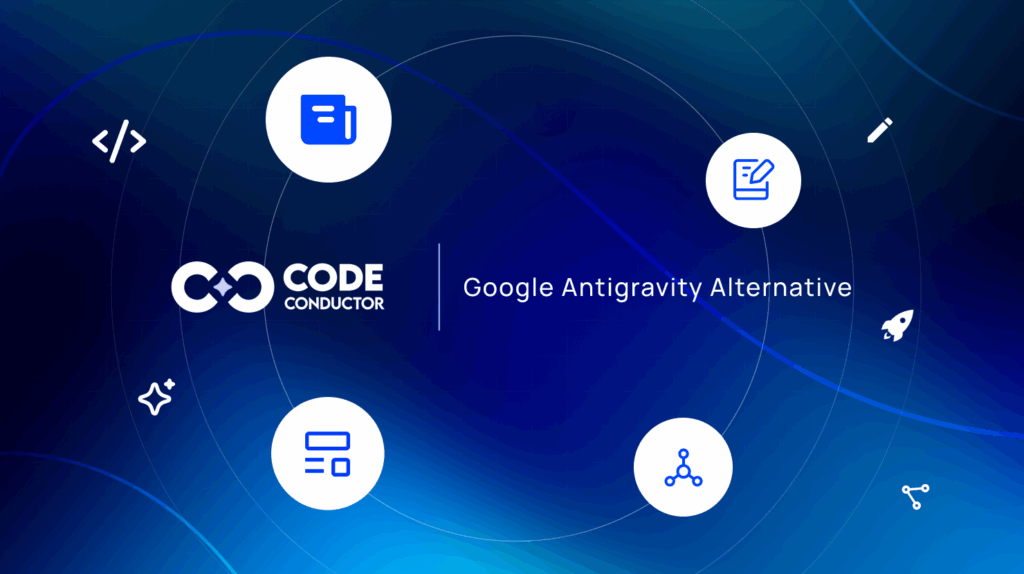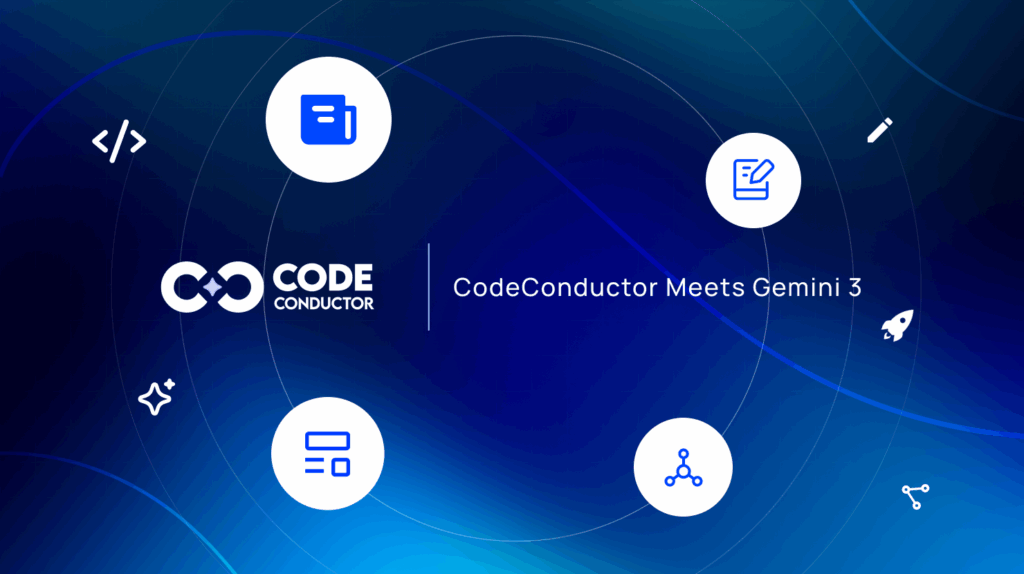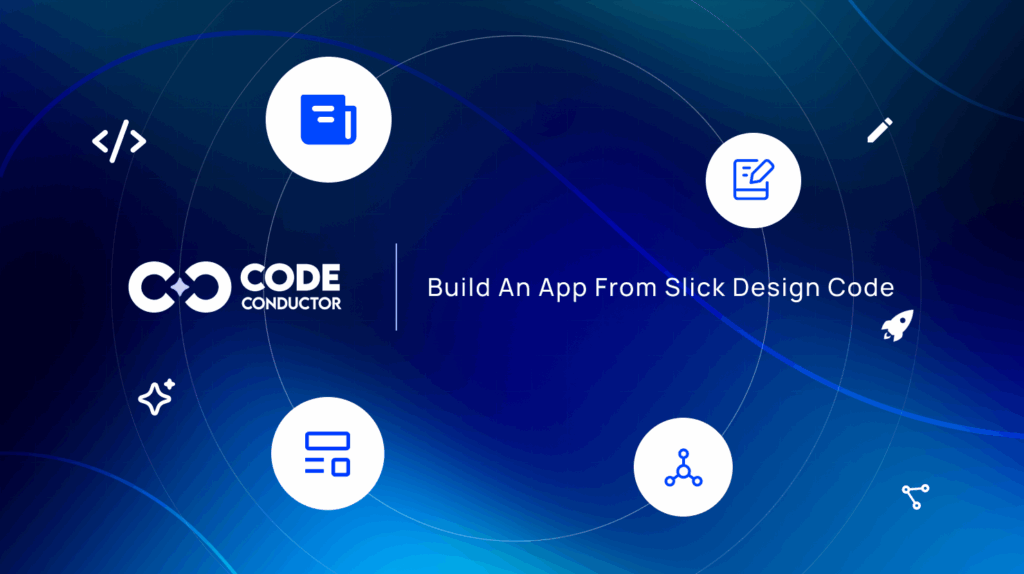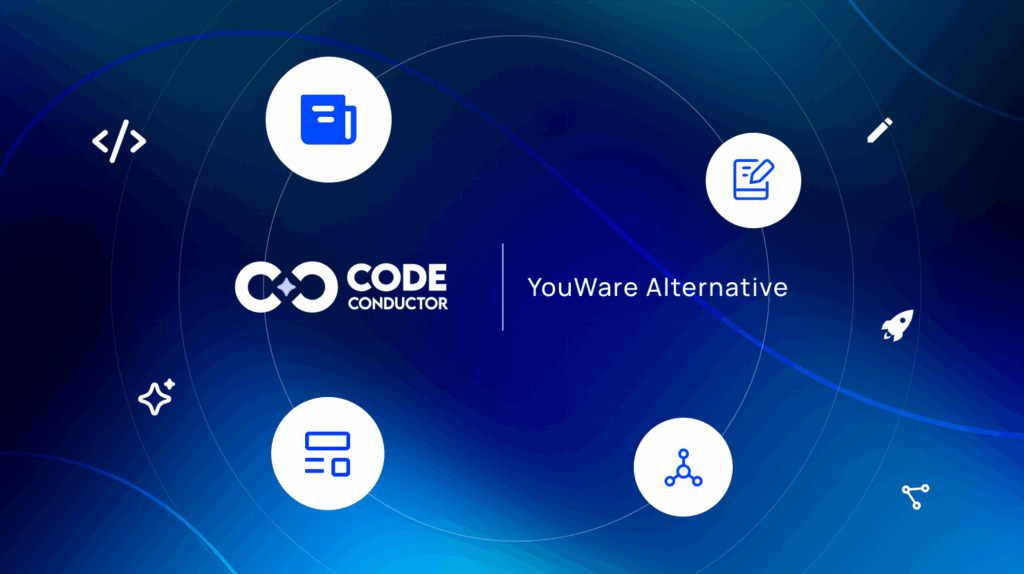Are you building AI-powered applications but running into limitations with your IDE’s memory, workflow flexibility, or integration capability?
That’s a challenge many developers now face with tools like Google Antigravity — an intriguing new “agent-first” coding platform from Google that promises advanced automation but still shows signs of an early-stage offering.
Google Antigravity delivers an impressive vision: embed autonomous AI agents directly into your IDE, let them manage tasks, inspect browser output, plan code changes, generate artifacts and manage workflows.
Simon Willison’s Weblog
But when your project grows from a playful prototype into a production-grade app with persistent data, complex integrations, team collaboration, versioning and deployment demands—this is where many teams find themselves hitting ceilings.
Enter CodeConductor — positioned not just as an alternative to Google Antigravity, but as the next-generation platform built from the ground up for production AI workflows, enterprise integrations and scalable deployments.
In the following sections we’ll unpack what Google Antigravity offers, explore why teams are seeking something more, compare features, and help you decide when CodeConductor is the right move ahead.
In This Post
- What Is Google Antigravity & What Does It Offer?
- Looking for the Best Google Antigravity Alternative in 2025?
- CodeConductor vs. Google Antigravity – Feature Comparison
- Which One Should You Use: Google Antigravity or CodeConductor?
- Real Feedback on CodeConductor
- In a Nutshell: Which Is the Best Alternative to Google Antigravity in 2025?
- FAQs
What Is Google Antigravity & What Does It Offer?
Google Antigravity is a new development environment from Google designed around an “agent-first” concept—where autonomous AI agents pursue tasks in a software project rather than simply assisting developers.
Core Purpose
Instead of being a typical IDE with AI autocomplete, Antigravity lets you spawn and manage one or more AI agents that have access to your code editor, terminal, and even a browser — letting them plan, execute, verify and document workflows.
Key Features
Here’s what stands out:
- Agent-First Design: Agents are treated almost like teammates—they plan subtasks, act on them, coordinate across workspaces.
- Artifacts for Transparency: Instead of just code output, Antigravity generates published “artifacts” such as task lists, implementation plans, screenshots, browser recordings, and diff logs so you can verify what the agent did.
- Two Work Modes:
- Editor View – Interface similar to common IDEs (with side-panel agents).
- Manager View – A control surface for orchestrating multiple agents, managing parallel tasks, and workspaces.
- Browser & Terminal Automation: Agents can open and control a browser, run tasks, test pages, and report on their actions.
- Learning from Past Work: Agents aren’t entirely stateless—they can store useful snippets or develop “memory” of previous task patterns for improved future performance.
- Multi-Platform Support & Preview Access: Antigravity is available in public preview for Windows, macOS, and Linux; free usage with generous rate limits during preview.
Who It’s For
Antigravity is geared toward developers, teams, and organisations who want to experiment with agentic workflows, automate software development at scale, or explore how AI can manage end-to-end tasks—not just write snippets of code. However, despite its ambitions, it is still early stage and more oriented toward prototyping and exploration rather than full production deployment as of now.
Looking for the Best Google Antigravity Alternative in 2025?
Google Antigravity has reimagined how developers interact with their IDE, introducing an agent-first architecture where autonomous coding agents take center stage. It’s fast, innovative, and ideal for experimental workflows. But for many teams, the novelty wears thin when real-world requirements kick in.
Here’s why more organizations are searching for a serious Google Antigravity alternative in 2025:
- They need structured workflows, not just task plans and browser recordings
- Their projects require persistent memory across user sessions and environments
- They want deep integrations with databases, APIs, auth systems, and cloud platforms
- They need real deployment options—not just artifacts or browser previews
- Teams demand collaboration, versioning, audit logs, and compliance-ready infrastructure
- Agent workflows are helpful—but production systems still need governed, reliable execution
That’s where CodeConductor emerges as the clear Google Antigravity alternative.
It combines the best of prompt-driven creation and AI-assisted development—while giving teams full control over architecture, data, deployment, and scale. Whether you’re building internal tools, user-facing AI apps, or automations that evolve with your stack, CodeConductor delivers enterprise-grade flexibility in a platform built to go beyond prototypes.
CodeConductor vs. Google Antigravity – Feature Comparison
Google Antigravity and CodeConductor both represent the future of AI-assisted app creation—but they serve very different goals. Antigravity is an agent-first experiment in autonomous software development, focused on exploration and ideation. CodeConductor is built for production-ready outcomes, where teams ship and scale real applications.
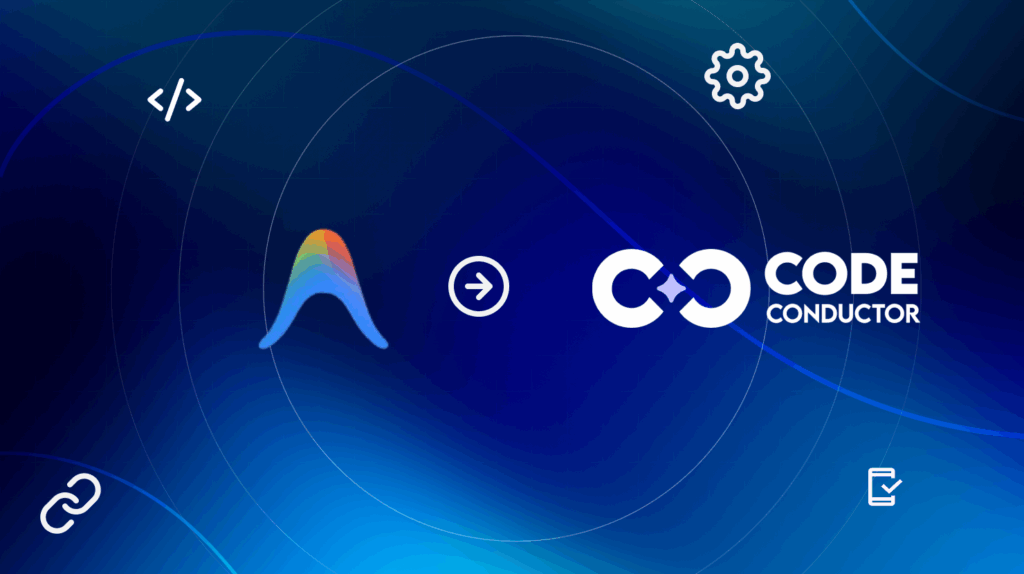
Here’s how the two compare side by side:
| Feature | Wonderful AI | Knolli.ai |
|---|---|---|
| Core Focus | Multilingual AI agents for customer-facing interactions and service workflows | Internal AI copilots that support finance, operations, and cross-team workflows |
| Primary Use Cases | Onboarding, claims, troubleshooting, scheduling, booking, dispute flows | Document-driven insights, workflow automation, reporting support, internal knowledge copilots |
| Technology Orientation | Voice-native agents with real-time speech understanding | Document + data-based copilots that analyze, summarize, and support decision tasks |
| Workflow Type | Interaction flows across voice, chat, and email | Internal operational workflows and team automation |
| Customization Style | Agent behavior tuning, enterprise routing, compliance controls | Configuration of copilots using documents, datasets, and team processes |
| Industry Strength | Finance onboarding, telecom support, healthcare scheduling, retail assistance, travel flows | Finance & ops teams, cross-functional workflows, internal tools, operational knowledge |
| Data Handling | Integrates with enterprise systems to support transactional agent steps | Works with uploaded documents, Sheets, internal data, and collaborative tools |
| Deployment Approach | Enterprise implementation for high-volume external interactions | Fast setup for internal teams wanting custom copilots |
| Best For | Organizations needing consistent customer interactions at scale | Teams needing analysis, operational clarity, and internal automation |
Which One Should You Use: Google Antigravity or CodeConductor?
Both platforms embrace AI-driven development—but what you choose depends entirely on what you’re building, who’s building it, and where you’re headed.
Use Google Antigravity if you’re experimenting with agent workflows:
- You’re a developer, researcher, or AI hobbyist exploring the frontiers of autonomous code generation
- You want to see what happens when agents manage tasks, test code, or interact with a browser
- You’re prototyping workflows and don’t need long-term persistence, strict reliability, or real deployments
- Your priority is experimentation—not product delivery
Use CodeConductor if you’re building real apps for users and teams:
- You’re launching internal tools, AI assistants, or customer-facing apps that need to persist, scale, and comply
- You need control over data, workflows, logic, deployment, and team collaboration
- Your app must connect with databases, APIs, cloud services, and authentication layers
- You want a no-code system that exports clean code, supports flexible hosting, and delivers production-ready performance
Google Antigravity is a glimpse of what AI agents can do.CodeConductor is the system that gets your AI app into the real world.
Real Feedback on CodeConductor
Francesca C. – Code Conductor Important tool
What do you like best about CodeConductor?
The code of conduct is used by my company for a series of behaviors to be observed towards colleagues and customers, it is very useful to understand all the regulations in your country.What do you dislike about CodeConductor?
It helped me on how to behave with a customer, what to say and not say to colleagues so as not to offend their sensitivity and avoid problems of incorrect conduct.What problems is CodeConductor solving and how is that benefiting you?
Helps with how certain corporate affairs should be resolved, such as managing corporate agreements with very important clients, avoiding making legal mistakes and getting into disputes with the country they belong to.
In a Nutshell: Which Is the Best Alternative to Google Antigravity in 2025?
If you want to explore the future of AI-assisted development through experimental workflows, autonomous agents, and interactive artifacts, Google Antigravity is an exciting place to start.
But if you’re ready to build applications that:
- Remember users and workflows across sessions
- Connect to APIs, databases, and cloud infrastructure
- Support roles, permissions, and version control
- Can be exported, deployed, and scaled in production
- Are secure, compliant, and ready for real customers
Then CodeConductor is the best alternative to Google Antigravity in 2025.
Antigravity shows you what agents can do. CodeConductor shows you what your team can launch.
Best Google Antigravity Alternative – Try it Free
FAQs
What is the best alternative to Google Antigravity?
CodeConductor is the best alternative to Google Antigravity in 2025. While Antigravity focuses on agent-based task automation within an IDE, CodeConductor offers persistent logic, full-stack code generation, production deployment, and team collaboration—ideal for building scalable, real-world AI applications.
Why would someone switch from Google Antigravity to CodeConductor?
Developers switch from Antigravity to CodeConductor when they need scalable app logic, multi-session persistence, enterprise-grade deployment options, and seamless API/database integration—features Antigravity doesn’t yet offer.

Founder CodeConductor

